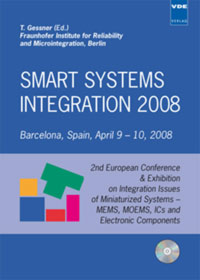A NEMS array for a signal to noise ratio improvement and mechanical filter design
Conference: Smart Systems Integration 2008 - 2nd European Conference & Exhibition on Integration Issues of Miniaturized Systems - MOMS, MOEMS, ICS and Electronic Components
04/09/2008 - 04/10/2008 at Barcelona, Spain
Proceedings: Smart Systems Integration 2008
Pages: 3Language: englishTyp: PDF
Personal VDE Members are entitled to a 10% discount on this title
Authors:
Kharrat, Chady; Colinet, Eric; Voda, Alina (CEA LETI – MINATEC, DCIS/SCME/LMEA, Grenoble, France)
Abstract:
Recently, sensors arrays begin to have an increasing attention in NEMS research field. The collective behavior of NEMS resonators systems can largely enhance the performance of resonator based devices (Radio frequency (RF) filters, mass sensors, magnetometers, scanning probe instruments, etc.) while preserving the most attractive features of micro/nanoelectromechanical resonators (superior quality factor, microminiature size, and compatibility with CMOS processes). When the size of the array exceeds hundreds or thousands of resonators, new capabilities can emerge which are unavailable for a single NEMS device. However, mechanical and electrical couplings between the individual NEMS make the whole system difficult to model and to control. Another limitation is the difference in their characteristic individual responses due to fabrication errors in these extremely small scales. Also, these responses, described by the individual transfer functions (ITF) and their quality factors, change according to functioning states and environment. Thus, electronic circuits associated to the electromechanical systems may become inappropriate. In this work, a NEMS array is designed to compensate these limitations and to benefit from the dispersion of the characteristic individual responses. As a result, a fixed known global transfer function (GTF) is obtained that is almost independent of the quality factors changes and which has the desired reference bandwidth resulting in a mechanical filter design. First the system architecture is described. In the second section, the piezoelectric detection is characterized and the electric global response is studied. Finally, simulation results are presented.


